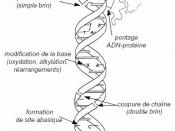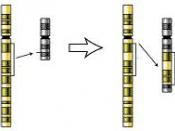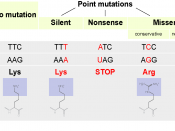A gene is a long sequence of nucleotides on a DNA molecule. A mutation is a change in the amount of an organism's genetic material and when a change in genotype produces a change in phenotype, the individual affected is said to be a mutant. A gene mutation involves a change in one or more of the nucleotides in a strand of DNA. The sequence of nucleotides in a gene controls the order in which amino acids are made into a protein, therefore if the sequence of nucleotides in a gene is altered by a mutation, then the order in which amino acids are made into a protein will be changed.
THE OCCURANCE OF MUTANT ALLELES & THE EFFECT OF MUTAGENIC AGENTS
Most gene mutations produce an inferior version of the phenotype, i.e. the majority of mutant alleles are recessive. If this results in death, then the altered allele is said to be lethal.
In the absence of outside influences gene mutations occur spontaneously and at random. Gene mutations also occur very rarely, i.e. they have a low frequency. Mutation rate can be artificially increased by mutagenic agents. These include certain chemicals such as mustard gas, x-rays and ultraviolet light. The resultant mutations are said to be induced.
TYPES OF GENE MUTATION & HOW THEY ALTER AMINO ACID SEQUENCE
There are four types of gene mutation which can occur in an organism; Substitution, Inversion, Deletion and Insertion. These four types of mutation can be categorised into point and frameshift mutations. Substitution, where an incorrect nucleotide is substituted for the correct one and Inversion, where two or more nucleotides are reversed, are examples of point mutations. On the other hand Deletion, where a nucleotide is deleted or lost from the sequence and Insertion, where an extra nucleotide is inserted into...


